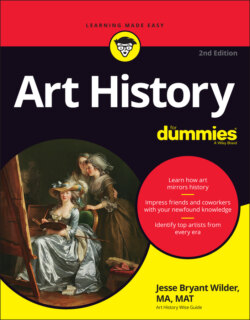Читать книгу Art History For Dummies - Jesse Bryant Wilder - Страница 133
Cool stick figures: The geometric style
ОглавлениеAt first glance, the paintings on vases from the tenth through eighth centuries BC look like the stick-figure doodlings of a child. Closer inspection reveals a complex network of geometric patterns: wraparound chains of Greek frets and chevrons (similar to a sergeant’s stripes), squares, dots, and squiggly lines, along with stick figures of people and animals. Geometric vases could also tell stories. The Dipylon krater (see Figure 7-8) at the Metropolitan Museum of Art shows stick figures pulling their hair out in mourning at the funeral pyre of a Greek warrior.
Rogers Fund / The Metropolitan Museum of Art
FIGURE 7-8: The Dipylon krater, Terracotta illustrates funerary scenes and was used as a grave marker c. 750–735 BC
In the next century, the more realistic Oriental style, which made a brief appearance, allowed for clearer visual storytelling. The neck of the Oriental-style amphora (a vessel used for storing and pouring wine or olive oil) The Blinding of Polyphemus and Gorgons depicts a scene from The Odyssey, in which Odysseus and his companions burn out the eye of the giant Cyclops Polyphemus. Odysseus pulls off this stunt by first getting the one-eyed giant drunk. The wine cup in the Cyclops’s hand suggests this earlier episode.
The Mesopotamian influence is confined to the figures. Odysseus and his men look like Mesopotamians, especially the upper part of the scorpion-man in the bottom band of Puabi’s lyre (refer to Figure 5-2 in Chapter 5). The animals in the middle band and the gorgons (sisters of the snake-haired Medusa) on the belly of the vase also have a Near-Eastern flavor. But the Greeks added their own playful charm to the monsters. If you look closely, you can see that the bug-eyed gorgons show off their sexy left legs like cancan dancers.
The belts of interlaced wavy lines (like basket weaving) at the top, bottom, and neck are leftovers from the Geometric period.
